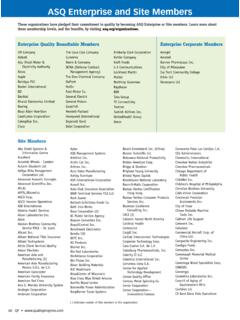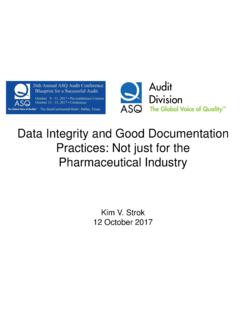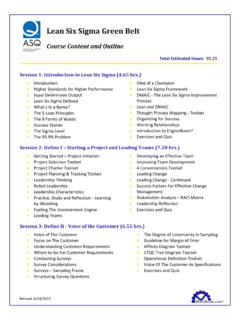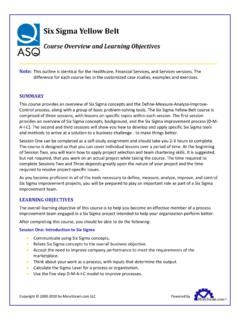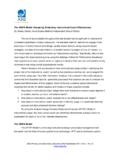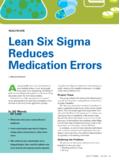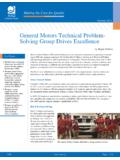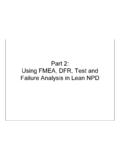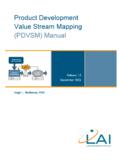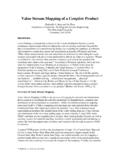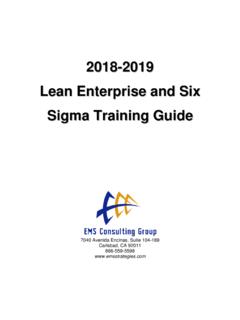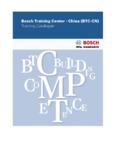Transcription of Ensuring Reliability in Lean New Product …
1 Ensuring Reliability in LeanNew Product DevelopmentJohn J. Paschkewitz, , CREO verview Introduction and Definitions Part 1: lean Product development lean vs. Traditional Product development Key Elements of lean NPD Customer Defines Value Front Loaded and Knowledge Based Eliminate Redesign Waste Reliability Requirements Part 2: Reliability Elements of lean NPD lean FMEA and DRBFM Critical Characteristics DFR and Physics of Failure Accelerated Testing to Failure Failure Analysis and Knowledge CaptureDefinitions Robustness performance is less sensitive tosources of variability (Ability to perform inunexpectedly severe environments)
2 Reliability probability that Product will performintended function for specified duration underexpected operating conditions Durability Product has acceptable useful lifewithout significant deterioration Quality Product delivers specified performancenew and each time it is usedPart 1:Introduction to lean New ProductDevelopmentOld Approach to Quality & Reliability Traditional companies(not yet on lean journey) Make all design decisions affecting quality andreliability at the individual design engineer level Pay little attention to historical failures Assume that the ownership for quality and reliabilitybelongs to groups named quality and Reliability Assume thatdesign does not significantly affectquality and Reliability , that quality and reliabilityfailures are caused by manufacturing and suppliersTypical Processes Staged development with Gate Reviews Used in Most Companies since 1980s.
3 1990s Characterized by Rework Loops when ProblemsEncountered Same as Competition Concept Selected Early Developed Until Problems Discovered Rework or Restart with New Concept Continue Until Schedule or Budget Limit Reached Results in Redesign Waste Milestone Based ProcessLean Approach to Quality & Reliability lean companies Prevent Product failures rather than react to them Create the culture to design quality and Reliability intotheir products Product development teams ensure that the qualityand Reliability issues of customers, manufacturing,service, and suppliers are properly represented Open communication channels with customers toobtain timely and detailed Product failure data Maintain a well-conceived failure database of productfield failure modes supported by failure analysis toroot cause Understand in detail the capabilities and limitations ofboth internal and suppliers' manufacturing operationsLean NPD Benefits Benefits of lean Frees resources formerly spent fighting quality andreliability brushfires.
4 Permitting tasks to be performedfaster and on-time Reduces warranty costs Makes it easier and cheaper for your manufacturingand your suppliers to produce quality products Increases sales because reliable products makehappy customers Creates an atmosphere and culture of doing thingsright the first timeLean Product development Concepts Customer Defines Value What is Customer Willing to Pay For? Eliminate Waste Front Loaded Process: Clear Requirements and Understanding CustomerNeeds and Wants Identify Knowledge Required to Satisfy CustomerRequirements Focus Resources on Key Tasks that Enable EssentialDecisions and Fully Explore Alternatives Knowledge Based Learn & UnderstandTraditional vs.
5 lean NPDD esign DecisionsMade as Early as PossibleDelayed as Long asPossibleDesign IterationsDesign is iterated untilspecification is met (orscheduled time reached)Specifications Convergewith DesignPrototyping and TestingVerification to determinewhat needs to be fixedBuild knowledge to makedecisions and achieveoptimal designsProject ManagementAdministrative Few peoplecreate task based plans andtrack progressTechnical Chief Engineerdefines Product conceptsand milestones. Engineerscreate their own plansManufacturingInvolvementManufacturi ng is followerand advisor receivesdesignCustomer drives and setstolerances and keycharacteristicsCategoryTraditionalLea nTo Change the Results, Change the ThinkingIf you want to change the results, you have to change the thinkingDEFINEREQUIREMENTSLIVE WITH ITDESIGNSOLUTIONFIND OUT ITDOESN T WORKOUT OFTIME ORMONEY?
6 NOT YETYESThe traditional process:TIMEDESIGN ALTERNATIVESTRADITIONALCOST OFALTERNATIVELEAN NPDTIMENPD RESOURCESLAUNCHTRADITIONALLEAN NPDTIMERISKL earning-First Product DevelopmentThe cost of doing Product development well is clear and cost of doing Product development poorly is vague and AGAINKNOWLEDGEF ocus on Learning to Accelerate the ProcessOut-learn the competition to shorten the development Lead TimeOnly exploration efficiently adds knowledge. Lock-In and Fix-Up add knowledge only about thecurrent solution. This doesn t help future projects or do much about a bad initial concept.
7 (MINIMIZE)(MAXIMIZE)(MINIMIZE)(MINIMIZE) REACTIONTime between theopportunityappearing and thedecision to investEXPLORATIONTime during whichmultiplealternativeimplementationsa re exploredLOCK-INTime during whichonly a singlesolution isdetailedFIX-UPTime during whichwe try to deal withthe problems withthe solution The biggest source of waste in NPD projects is lack of knowledge when adecision must be made (results inguessing). Guessing usually results in rework that extends schedules. If you want to shorten project lead time, stop the guessing.
8 To stop the guessing, increase the time NPD Characteristics Intense Focus onValue Creation Standardized Work Processes DevelopInformation as Needed(Pull) Parallel Processing Integration Events Eliminate Wasteand UnnecessaryHandoffs Up Front Learning Test First, ThenDesign Flexible Resource Loading & TimingCost Benefit Of lean NPDRon Masticelli, lean Producr development Guidebook, 2007 Learning from Failures Look at lean NPD as a Failure ModeFactory * Learn by finding and fixing the Product andprocess failures before they reach the customer lean NPD is a Knowledge Work Job Shop** lean NPD is Conducive to Applying HALT,DOE.
9 And Accelerated Test to BuildKnowledge and Improve Design Decisions* Dr. Nathan Soderborg, DFSS Master Black Belt, Ford WCBF DFSS Conference, Feb 10 2008** Morgan & Liker,The Toyota Product development System, 2006, p. NPD Principles Define Value Be Certain What the CustomerValues (Understand the Real Need) Identify Value Stream Tasks and ResourcesThat Add Value at Right Time Create Value Flow Get Rid of Wasted Activity,Do Only Tasks That Add Value Establish Pull Deliverables Late as Possiblewith Maximum Knowledge Seek Perfection Continuous Improvementand LearningLean NPD Support Top Management Support is Essential Must be part of broader organizational leanjourney Probably an extension of previous leanmanufacturing efforts lean Consultants can Facilitate Transitionto lean NPDU nderstand Customer Needs Voice of the Customer True Needs Understand What DrivesThem Develop Vision of Product with CustomerKano Diagram Customer ExpectationsKano
10 ModelHow well need is metBasic needsPerformanceNeeds Linear SatisfierDelightersSatisfactionUse Voice of the Customer (VOC) Sessions to IdentifyWell DoneAbsentDiminishing SatisfierTimeCustomer Defines Value Product and Priorities Established withCustomer: What is Absolutely Essential? Areas of Potential Compromise / Trade-off True Need for Targets and Features Opens Door for Possible Alternatives and a BetterSolution to the Customer s ProblemAgreement on Needs Based on the weighting, Kano and effort rating,sort the needs into four (4) categories: What do we want to excel at?

